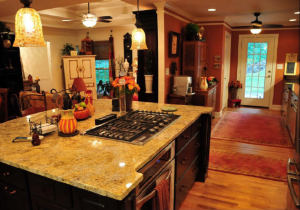Too Darn Hot! What Every Homeowner Needs To Know About Their Air Conditioning Unit
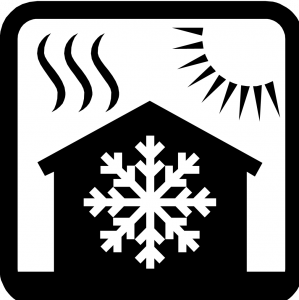 With Summer just beginning to heat up, and record temperatures already being reported throughout Hotlanta and all across Georgia – your air conditioning is something you definitely should NOT take for granted. Thanks to some help from our friends at the Air Conditioning, Heating and Refrigeration Institute (AHRI), Highlight Homes has compiled a list of some basic facts about how your air conditioning works, the best ways to maintain your unit, and valuable energy saving tips that could save you money.
With Summer just beginning to heat up, and record temperatures already being reported throughout Hotlanta and all across Georgia – your air conditioning is something you definitely should NOT take for granted. Thanks to some help from our friends at the Air Conditioning, Heating and Refrigeration Institute (AHRI), Highlight Homes has compiled a list of some basic facts about how your air conditioning works, the best ways to maintain your unit, and valuable energy saving tips that could save you money.
How Central Air Conditioning Works:
A/C units are comprised of three basic components and a chemical in order to cool your home. The chemical in your A/C is known as a refrigerant, and the three mechanical components that convert the refrigerant from a gas to a liquid and back again are the compressor, the condenser and the evaporator coil. All of these pieces of the puzzle work together to transfer heat from inside your home to the outside air. This process begins when the refrigerant arrives at the compressor as a cool, low-pressure gas. It leaves the compressor as a hot, high-pressure gas and enters the condenser. A fan draws air from the outdoors which cools the refrigerant and changes it to a high-pressure liquid before moving it indoors through tubing which converts it to a low-temperature, low-pressure liquid by the time it hits the evaporator coil. The evaporator coil serves to absorbs moisture in the air through the return vents while a powerful fan blows over the coil and the refrigerant – ultimately cooling the home through air supply vents. Once the refrigerant leaves the evaporator coil, it returns to the compressor as a gas and the cycle begins all over again until the desired temperature you have set on your thermostat is reached.
Most homes typically have one of two central air conditioning units – a split system or a package system. A split system (described in the cycle above) consists of an outdoor metal cabinet, which houses the condenser and compressor, and an indoor cabinet that contains the evaporator coil. The outdoor cabinet is located next to the home and the evaporator coil is located inside the home, near the furnace – often in an attic, basement or crawlspace. It is important that the outdoor and indoor units are properly matched for efficiency. In a package system, all of the mechanical parts are housed in one cabinet, which is usually located outside the house.
Maintenance (and Money-Saving) Tips for A/C Systems:
We’re fairly sure you’ve heard the phrase “You don’t know what you’ve got ‘til it’s gone.” Air conditioning is something you definitely do not want to go without, especially during the hottest months of the year in Atlanta, July and August. Aside from escaping unbearable temperatures and humidity, these maintenance tips can also help save you some money in the long-run!
- Get in the habit of checking your air filters regularly. Change them according to the manufacturer’s recommendation or if they are particularly dirty. By changing the filter, you are keeping dust from collecting on the evaporator coil, but clean filters can also cut energy consumption 5 percent to 15 percent. Turn off the power to the furnace before pulling the filter out so the blower doesn’t come on and blow dust throughout the system. Be sure to position the filter according to the manufacturer’s instructions.
- Take a walk outside to check the outdoor condensing unit, which is typically a large (sometimes noisy) metal box on the side of your house. Clear away debris such as leaves, grass clippings, weeds and plants that could block airflow and reduce its efficiency. You can also clean the outdoor condensing unit by spraying it off with a garden hose.
- Make sure that all of the vents in the house are unobstructed. Air in your home needs to circulate easily through the vents. If you have floor registers, make sure they are not blocked by furniture.
- Close off unused rooms and close vents in those rooms so that your A/C unit isn’t having to work overtime to cool the WHOLE house needlessly.
- Make sure your home is properly sealed and insulated – which can reduce your total energy use by more than 20 percent. Focus first on ducts that run through unconditioned space such as your garage or attic, and seal ducts with mastic or foil-backed tape. After sealing, insulate the ducts by wrapping them in insulation. The Department of Energy recommends minimum insulation levels for each part of the home, based on your climate. For more information regarding YOUR recommended insulation level, visit the ENERGYSTAR website at www.energystar.gov.
- Install a programmable thermostat. According to the Environmental Protection Agency (EPA), a programmable thermostat can save you about $150 a year in energy costs if it is properly used. It is recommended for people who are away from home during set times of the day throughout the week. A word of warning – resist the urge to override the pre-programmed settings. Every time you do, you use more energy and may end up paying more on your energy bill. Set the “hold” button at a constant energy-saving temperature when going away for the weekend or on vacation. Install your thermostat away from heating or cooling registers, appliances, lighting, doorways, skylights, and windows, and areas that receive direct sunlight or drafts as they may give the thermostat “false” readings. Interior walls are typically best.
- At the beginning of the season (typically Spring or Fall), hire a knowledgeable and experienced professional to service your central cooling and heating system. A well-trained technician will find and fix problems BEFORE they become a major issue. Make sure they:
- Check for the correct amount of refrigerant and test for refrigerant leaks.
- Capture any refrigerant that must be evacuated from the system.
- Check for and seal duct leakage in central systems.
- Measure air flow through the evaporator coil.
- Check the accuracy of the thermostat.
- Verify the correct electric control sequence and make sure that the heating system and cooling system cannot operate simultaneously.
- Inspect electric terminals, clean and tighten connections, and apply a non-conductive coating if necessary.
- Oil motors and check belts for tightness and wear. Loose belts can increase furnace operating time. Replace frayed or cracked belts. Two or three drops of oil in the motor will keep it running smoothly. (Sealed blower motors require no lubrication. If you have questions, check your owner’s manual or call a heating professional.)
- Make sure blower doors are replaced properly. This keeps combustion byproducts such as carbon monoxide separate from the warm air circulated through your home.
- Check to see that the exhaust flue to the outside is clear of obstructions and in good condition from the furnace to the roof cap with all connections securely fastened. A contractor will check it by removing the flue cap near the furnace and water heater and looking through the flue to the outside. The flue cap needs to be replaced securely. If the furnace or water heater is in an enclosed room or closet, they need to get plenty of air. These appliances need ten cubic feet of air for one cubit foot of natural gas to operate properly. Furnace rooms or closets should have door louvers or vents or a duct directly to the outside to provide sufficient combustion air.
If need be, replace old or failing mechanical equipment. Keep in mind that the average life span of central air conditioning systems is 12- to 15-years (IF it is properly installed and maintained). If your heating or cooling equipment is more than 10 years old, needs expensive repairs, or no longer keeps you comfortable, it may be time to go ahead and replace it. When replacing, look for performance certified equipment, which guarantees you that the manufacturers’ claims of energy efficiency performance are accurate. You can search the free AHRI Directory of Certified Product Performance to find certified HVAC equipment and compare the efficiency ratings of different models. While replacement may seem like an expensive undertaking, now that air conditioning systems are required BY LAW to have a seasonal energy efficiency ratio (SEER) of 13 or higher, you will likely see reduced utility bills. Make sure you are working with a qualified installer who will properly size and install the correct equipment for your home. Check with friends, family and colleagues to find an installer you trust – and you may want to get quotes from several companies. It also vital that the duct work be installed properly. Otherwise, poorly installed duct work can result in less than efficient system performance and higher than expected utility bills.
Federal Tax Credits:
If you do find you need to replace your air conditioning system, Highlight Homes highly recommends that you select an energy efficient model. In doing so, you may be eligible for federal tax credits under The American Recovery and Reinvestment Act of 2009 – but HURRY, these energy efficient tax credits are for equipment placed in service on or before December 31, 2010. For residential central A/C units, an eligible split system must have a stated performance rating of 13 EER (energy efficiency rating – the higher, the better) and 16 SEER (seasonal energy efficiency ratio) for a tax credit of 30% of the total cost of the unit (price of the product itself + installation). An eligible package system must have a stated performance rating of 12 EER and 14 SEER. The maximum credit is $1,500.
 For more information about air conditioning systems and to find a list of certified products, visit the Air Conditioning, Heating and Refrigeration Institute online at www.ahrinet.org. To learn more about Highlight Homes and their NEW design-build remodeling division, visit www.highlighthomesga.com. When you’re ready to begin the exciting design phase of your really COOL home renovation or to lay the groundwork for the HOTTEST (and most energy efficient) custom-built house on the block, call Highlight Home Restoration and Highlight Homes, LLC at 678-873-9234.
For more information about air conditioning systems and to find a list of certified products, visit the Air Conditioning, Heating and Refrigeration Institute online at www.ahrinet.org. To learn more about Highlight Homes and their NEW design-build remodeling division, visit www.highlighthomesga.com. When you’re ready to begin the exciting design phase of your really COOL home renovation or to lay the groundwork for the HOTTEST (and most energy efficient) custom-built house on the block, call Highlight Home Restoration and Highlight Homes, LLC at 678-873-9234.
Cite: Porter. Cole. “Too Darn Hot” Kiss Me Kate. 1948.
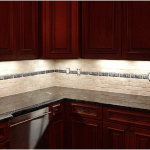 Light Up the Heart of the Home
Light Up the Heart of the Home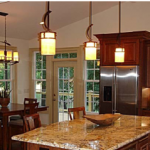 Don’t be afraid to blend contemporary designs with vintage touches, classic with art deco, or chic with traditional. Have fun with your lighting choices – but use similar colors or metals to tie everything together (e.g. Brushed Nickel or Black).
Don’t be afraid to blend contemporary designs with vintage touches, classic with art deco, or chic with traditional. Have fun with your lighting choices – but use similar colors or metals to tie everything together (e.g. Brushed Nickel or Black). Knock-Knock
Knock-Knock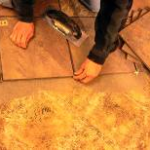 It’s not just for bathrooms anymore! Found on the walls, floors and ruins of ancient mosques and Roman temples, 2010 would not be one of the first times tile was in fashion. Well-known for its durability (ceramic tile can last 50+ years in modern homes), tile manufacturers are getting more and more creative with their designs. Made from a wide variety of elements such as porcelain, stone, glass and clay – tile can also come in a broad assortment of patterns, colors and textures. It can be made to look like rock, concrete, leather, reptile skin, marble and more. A really good tile contractor can design a one-of-a-kind pattern in your floor with tile inlays, alternating colored tiles and glass mosaic elements. Your floor could well become a work of art.
It’s not just for bathrooms anymore! Found on the walls, floors and ruins of ancient mosques and Roman temples, 2010 would not be one of the first times tile was in fashion. Well-known for its durability (ceramic tile can last 50+ years in modern homes), tile manufacturers are getting more and more creative with their designs. Made from a wide variety of elements such as porcelain, stone, glass and clay – tile can also come in a broad assortment of patterns, colors and textures. It can be made to look like rock, concrete, leather, reptile skin, marble and more. A really good tile contractor can design a one-of-a-kind pattern in your floor with tile inlays, alternating colored tiles and glass mosaic elements. Your floor could well become a work of art.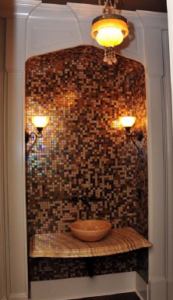 girl’s/boy’s room, outhouse, potty, privy or the john – the number one trend that’s sweeping the nation in bathroom remodeling is the transformation from a “necessary” room into a luxury retreat, something more worthy of the title “REST”room. More and more people are looking to their bathrooms as a place of relaxation and peace – a place where they can wash away the stresses of the day, calmly gear up for the day ahead or get all dolled up for an evening on the town. As this trend grows, more homeowners are looking to professional designers and remodelers to add special luxury finishes to this often-overlooked room of the house. We have compiled a list of the latest must-haves for bathrooms in 2010. We hope they make you “flush” with excitement!
girl’s/boy’s room, outhouse, potty, privy or the john – the number one trend that’s sweeping the nation in bathroom remodeling is the transformation from a “necessary” room into a luxury retreat, something more worthy of the title “REST”room. More and more people are looking to their bathrooms as a place of relaxation and peace – a place where they can wash away the stresses of the day, calmly gear up for the day ahead or get all dolled up for an evening on the town. As this trend grows, more homeowners are looking to professional designers and remodelers to add special luxury finishes to this often-overlooked room of the house. We have compiled a list of the latest must-haves for bathrooms in 2010. We hope they make you “flush” with excitement!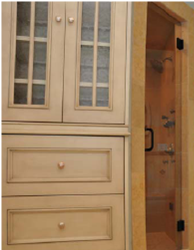 Drawers, Doors and More – While many homeowners still share a fondness for the classic medicine cabinet, more emphasis is now being placed on innovative storage solutions. Lots of small drawers with dividers, deep cabinets to hold extra towels, and vertical storage units are leading the way to less cluttered countertops and a cleaner look in bathrooms.
Drawers, Doors and More – While many homeowners still share a fondness for the classic medicine cabinet, more emphasis is now being placed on innovative storage solutions. Lots of small drawers with dividers, deep cabinets to hold extra towels, and vertical storage units are leading the way to less cluttered countertops and a cleaner look in bathrooms.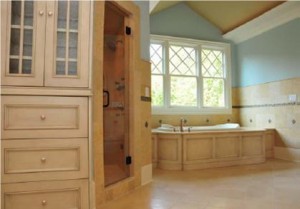 According to reports late last year from Pantone, the global authority on color and provider of professional color standards for the design industries, THE hottest color for 2010 is turquoise. Believed by many cultures to be a talisman color – inspired by the sea and sky, it’s a shade associated with deep compassion, healing, faith and truth. Not only is it a soothing color to add to one to all four walls of a room, it’s a terrific shade to add as a SPLASH of color through throw pillows, lamps and other décor accessories. Pantone leads the way for builders, painters, interior designers, and fashion designers all over the world. And – while most paint companies have taken cues from Pantone regarding color trends for 45 years, some are setting a few trends of their own.
According to reports late last year from Pantone, the global authority on color and provider of professional color standards for the design industries, THE hottest color for 2010 is turquoise. Believed by many cultures to be a talisman color – inspired by the sea and sky, it’s a shade associated with deep compassion, healing, faith and truth. Not only is it a soothing color to add to one to all four walls of a room, it’s a terrific shade to add as a SPLASH of color through throw pillows, lamps and other décor accessories. Pantone leads the way for builders, painters, interior designers, and fashion designers all over the world. And – while most paint companies have taken cues from Pantone regarding color trends for 45 years, some are setting a few trends of their own.